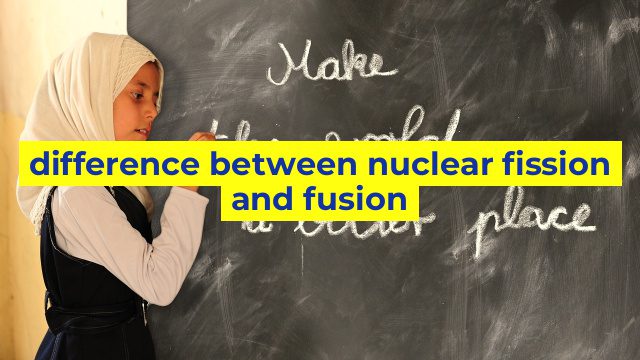The Difference Between Nuclear Fission And Fusion
Nuclear fission and fusion are two types of nuclear reactions with very different characteristics. Understanding these differences can help us appreciate the benefits and limitations of nuclear energy and make informed decisions about its use.
Nuclear Fission
Nuclear fission is the process by which a heavy nucleus splits into two or more lighter nuclei, releasing a large amount of energy in the form of kinetic energy and radiation. This reaction can be achieved by bombarding the nucleus with a neutron, which causes it to become unstable and split apart.
In nuclear power plants, nuclear fission is used to generate heat, which is then used to produce steam and drive turbines that generate electricity. However, nuclear fission also produces highly radioactive waste products that can remain dangerous for thousands of years, posing significant challenges for their safe storage and disposal.
Nuclear Fusion
Nuclear fusion is a process in which two lighter nuclei combine to form a heavier nucleus, releasing an enormous amount of energy in the process. This reaction occurs at extremely high temperatures and pressures, conditions that can be found in the sun and other stars.
While nuclear fusion has enormous potential as a source of clean and virtually limitless energy, it has proven extremely difficult to achieve on Earth. The temperature and pressure required to initiate the reaction are so high that they have yet to be achieved in a practical and cost-effective way.
Conclusion
While both nuclear fission and nuclear fusion involve the release of energy from the nucleus of an atom, they are very different processes with distinct characteristics and potentials. Nuclear fission is currently the most practical means of generating nuclear energy, but it produces highly radioactive waste products that pose significant challenges for their storage and disposal. Nuclear fusion, on the other hand, has enormous potential as a source of clean energy, but current technology has yet to achieve the temperatures and pressures required to initiate the reaction. Ultimately, informed decision-making about the use of nuclear energy requires an understanding of the differences between these two processes and their relative benefits and limitations.
Table difference between nuclear fission and fusion
| Factor | Nuclear Fission | Nuclear Fusion |
|---|---|---|
| Definition | The process of splitting a large nucleus into smaller nuclei, releasing energy in the form of heat or light. | The process of combining two atomic nuclei to form a heavier nucleus, releasing a large amount of energy. |
| Nuclear fuel | Heavy elements like uranium-235, plutonium-239, and thorium are used for nuclear fission. | Light elements like hydrogen, helium, and lithium are used for nuclear fusion. |
| Reaction | Unstable nucleus of heavy elements is bombarded with neutrons to split it into smaller fragments. | Two light atomic nuclei are fused together at extremely high temperatures and pressure to form a heavier nucleus. |
| Energy release | Energy is released in the form of heat, light, and radiation. | Energy is released in the form of heat, light, radiation, and high-speed particles. |
| Applications | Used in nuclear power plants to generate electricity and nuclear weapons. | Has the potential to power the future through clean energy sources like fusion-based power plants. |

